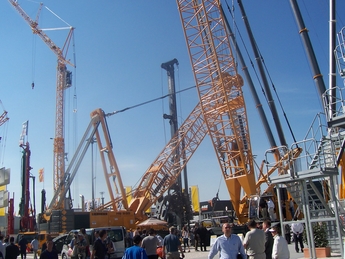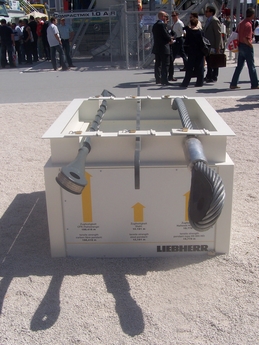At Bauma 2007, Liebherr-Werk Nenzing managing director Walter Länge and Liebherr Nenzing Crane Company vice president Gernot Schranz explained how, and why, the company has developed new carbon fibre pendants for two of its newest crawler cranes.
The carbon fibre pendants are incredibly light, by comparison with steel versions, but equally strong. The material is known as CFK. Walter Länge explained, "We developed CFK for crawler cranes. It's standard for the HS 895 HD, and available as an option for the LR 1300. On long boom crawler cranes, weight is essential. On self-erecting crawlers, we can erect an additional six metres of boom using CFK. It is also fatigue proof. With steel bars, there is a limited service life. With CFK, there isn't. It offers a higher lifting capacity at maximum radius."

Liebherr carbon-fibre display at Bauma
Länge continued, "The carbon fibre material was developed by Carbo-Link, a commercial spin-off of the University of Zurich, based at EMPA (the Swiss Federal Laboratory for Materials Testing and Research). It's produced in the lab at the moment, but is slowly being moved to industrial production. It's a very high tech process, and very expensive to produce. The more we sell though, the cheaper it will become. We are still far from industrial production: it's not a simple process, it needs a lot of process control."

A HS 895 at Bauma 2007, with CFK pendants
This high tech process comes at a cost, and for now will limit the applications the material is put to. Schranz said, "It's only cost effective on longer booms. Right now, the fibre carbon pendants are only cost effective on the HS 895. We would normally use heavy steel rope pendants with steel connectors. On this crane, that kind of steel pendant is also expensive, so the cost difference is less: using carbon fibre here is almost cost neutral. On a lift crane, carbon fibre is still very expensive, but we hope costs will come down."

A HS 895 HD and LR 1300 at Bauma 2007, with CFK pendants
He continued, "Now, we're gaining experience in the field, under tough operating conditions, so we can tell customers we have a life history of the product. In France, we erected an 895 with just two guys lifting the securing carbon fibre pendants manually, without a support crane."

CFK pendants on the lower boom of an LR 1300
Finding the best way to use the material was no easy task. "The main problem we faced was the termination point," said Länge, "You have very high stresses at the end point. We had to design and fabricate it not to overload at this point. All of these bars also have problems with vortex shedding. This is where wind passes over the bar, making it vibrate. In certain conditions, this can cause the bar to arrive at the harmonic resonance, severely stressing the bar. The spiral design used in some of the bars reduces this."

A side view of the CFK display at Bauma 2007. Note the spiral pattern on the left pendant, designed to prevent vortex shedding.
Länge said, "At the moment, we still use traditional steel pendant straps, we could replace them with carbon fibre, but haven't yet. We could, potentially, make booms, everything, out of carbon fibre.”
Liebherr carbon-fibre display at Bauma Liebherr carbon-fibre display at Bauma CFK pendants on the lower boom of an LR 1300 LR 1300 pendants A HS 895 HD and LR 1300 at Bauma 2007, with CFK pendants HS 895 and LR 1300 A HS 895 at Bauma 2007, with CFK pendants HS 895 CFK A side view of the CFK display at Bauma 2007. Note the spiral pattern on the left pendant, designed to prevent vortex shedding. CFK display side




